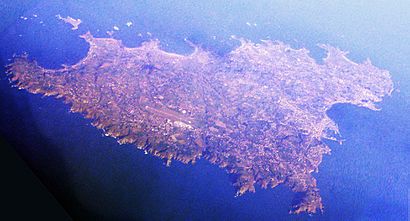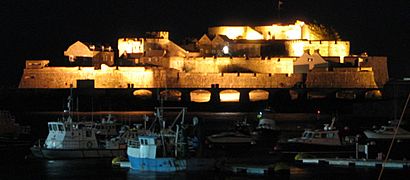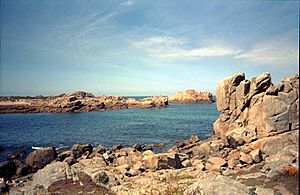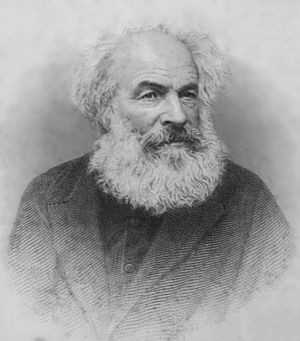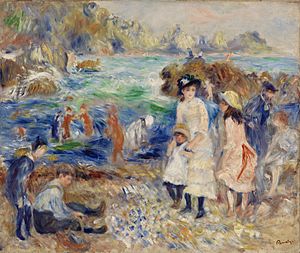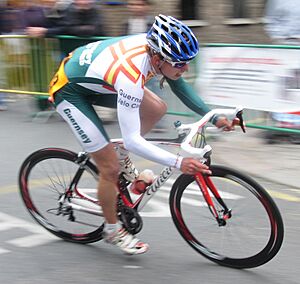Guernsey facts for kids
Quick facts for kids
Guernsey
|
|||
|---|---|---|---|
|
|||
| Anthem: "Sarnia Cherie" | |||
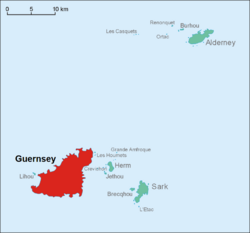
Map of Guernsey within the Bailiwick
|
|||
| Sovereign state | United Kingdom | ||
| Crown Dependency | Bailiwick of Guernsey | ||
| Separation from the Duchy of Normandy | 1204 | ||
| Capital and largest city
|
Saint Peter Port 49°27′36″N 2°32′7″W / 49.46000°N 2.53528°W |
||
| Official languages | |||
| Recognised regional languages | |||
| Ethnic groups | |||
| Demonym(s) |
|
||
| Government | Parliamentary constitutional monarchy | ||
| Charles III | |||
| Richard Cripwell | |||
|
• Bailiff
|
Sir Richard McMahon | ||
|
• Chief Minister
|
Lyndon Trott | ||
| Legislature | States of Guernsey | ||
| Area | |||
|
• Total
|
62 km2 (24 sq mi) | ||
|
• Water (%)
|
0 | ||
| Population | |||
|
• 2022 census
|
63,950 (207th) | ||
|
• Density
|
965/km2 (2,499.3/sq mi) | ||
| GDP (PPP) | 2018 estimate | ||
|
• Total
|
£3.272 billion | ||
|
• Per capita
|
£52,531 | ||
| Currency | Guernsey pound Pound sterling (£) (GBP) |
||
| Time zone | UTC+00:00 (GMT) | ||
|
• Summer (DST)
|
UTC+01:00 (BST) | ||
| Date format | dd/mm/yyyy | ||
| Driving side | left | ||
| Calling code | +44 | ||
| UK postcode |
GY1–GY8
|
||
| ISO 3166 code | GG | ||
| Internet TLD | .gg | ||
Guernsey (pronounced GURN-zee) is a beautiful island located in the Channel Islands. It is the second-largest island in this group. You can find it about 43 kilometers (27 miles) west of France.
Guernsey is the biggest island in the Bailiwick of Guernsey. This Bailiwick also includes five other islands where people live: Alderney, Herm, Jethou, Lihou, and Sark. There are also many smaller rocks and islets. The Bailiwick has about 63,950 people, and most of them live on Guernsey. The island itself is about 62 square kilometers (24 square miles) in size.
Guernsey used to be part of the Duchy of Normandy until 1204. At that time, the Channel Islands chose to stay loyal to the English King, separating from mainland Normandy. In 1290, the islands were divided, and Guernsey became part of the Bailiwick of Guernsey.
During World War II, Guernsey was taken over by Nazi Germany. After five years, the island was set free on May 9, 1945. This day is now celebrated every year as Liberation Day.
Guernsey is a self-governing area that is connected to the British Crown. It is not part of the United Kingdom, but the UK government helps with some things. The British monarch is the head of state. The main leader of the government is the President of the Policy and Resources Committee. The island's government is called the States of Guernsey.
The island is split into ten parishes. Its only town is Saint Peter Port. The King of England is seen as the "Head of State" or the "successor to the Duke of Normandy."
Guernsey's biggest business is financial services, like banking. Tourism and farming are also important. The island is very famous for its special cows. Guernsey's culture is much like Britain's, with English being the main language and using the pound sterling money. But French culture also has an impact, especially with the island's traditional language, Guernésiais. The famous French writer Victor Hugo lived in Guernsey for 15 years and wrote some of his best books there.
Contents
Discovering Guernsey's Past: A Journey Through Time
What's in a Name? The Origin of "Guernsey"
The name "Guernsey" comes from an old language called Old Norse. It means "island." The exact meaning of the first part, "guern(s)," is not fully known. It might come from a person's name or from a word for pine tree.
Long ago, the Channel Islands had other names, like the Lenur islands. Guernsey was sometimes called Sarnia or Lisia.
Early History: From Ancient Seas to Norman Rule
Around 6000 BC, the sea levels rose, creating the English Channel. This separated Guernsey and Jersey from mainland Europe. Early farmers then settled on the coast and built large stone structures called dolmens and menhirs. You can still see these today.
Later, people from Britain settled on the islands. Saint Sampson is believed to have brought Christianity to Guernsey. In 933 AD, the French King gave control of the islands to William I. Guernsey and the other Channel Islands are the last parts of the old Duchy of Normandy.
During the Middle Ages, Guernsey was a hiding place for pirates. They would trick ships into crashing near the island. This became worse during the Hundred Years' War, when French forces took over the island several times. The Royal Guernsey Militia was formed in 1337 to help defend the island.
In 1372, mercenaries from Aragon, led by Owain Lawgoch, invaded the island. He was working for the French king. Owain and his soldiers became part of Guernsey's legends, seen as invading fairies from across the sea.
Modern History: Wars, Changes, and Growth
In the mid-1500s, Guernsey was influenced by a religious movement called Calvinism. During a time of religious persecution, three women, known as the Guernsey Martyrs, were burned at the stake for their Protestant beliefs.
During the English Civil War, Guernsey supported the Parliamentarians. However, Castle Cornet remained loyal to the King until it surrendered in 1651. It was the last Royalist stronghold to give up in the British Isles.
In the 17th and 18th centuries, wars with France and Spain allowed Guernsey shipowners to become privateers. They used their merchant ships to attack enemy vessels.
By the 1700s, some Guernsey residents started moving to North America. Many forts were built to protect the island from Napoleon at the end of that century. The 1800s brought great wealth to the island, thanks to its success in global shipping and the growth of its stone industry.
20th Century: World Wars and Recovery
During World War I, about 3,000 men from Guernsey served in the British army. About 1,000 of them were in the Royal Guernsey Light Infantry.
For most of World War II, German troops occupied the Channel Islands. Before the occupation, 80% of Guernsey children were sent to England for safety. Some never saw their families again. The Germans also sent over 1,000 Guernsey residents to camps in Germany. Guernsey was heavily fortified during the war, much more than its importance suggested. Life was very hard for the people on the island, especially after June 1944. Many German defenses still stand today.
After the war, in the late 1940s, the island fixed its damaged buildings. The tomato farming business grew again but declined in the 1970s. Tourism has remained important. Financial businesses started growing in the 1970s and became major employers in the next two decades.
Exploring Guernsey's Landscape and Weather
Guernsey's Location and Natural Features
Guernsey, along with Herm and some other smaller islands, covers a total area of about 71 square kilometers (27 square miles). Their coastlines stretch for about 46 kilometers (29 miles). The land goes from sea level up to 110 meters (361 feet) at Hautnez on Guernsey.
There are many small islands, rocks, and reefs around Guernsey. The tides can rise and fall by 10 meters (33 feet), and currents can be very fast, up to 12 knots. This makes sailing in these waters quite challenging.
Guernsey island has about 63,000 people living on its 62 square kilometers (24 square miles). It is the main center for laws, government, shopping, and services for the whole area. The parliament for the entire Bailiwick of Guernsey, including Herm, Jethou, Lihou, and Alderney, is called the States of Guernsey.
Guernsey's Climate: Mild Winters and Sunny Summers
Guernsey has a mild climate. Winters are not too cold, and summers are warm and sunny. The warmest months are July and August, with temperatures usually around 20°C (68°F). Sometimes, it can get above 24°C (75°F). February is usually the coldest month, with an average temperature of 6°C (43°F).
Snow rarely falls and usually does not stay on the ground. It is most likely to snow in February. The temperature rarely drops below freezing. However, strong winds from the Arctic can make it feel much colder. The rainiest months are December, November, and January. July is the sunniest month, with about 250 hours of sunshine. December has the least sunshine.
Guernsey's Economy: How the Island Makes Money
Financial services are Guernsey's biggest business. They make up about 37% of the island's total income. This includes banking, managing money for others, and insurance. Tourism, manufacturing, and growing plants (like tomatoes and freesias) used to be bigger but have become less important. Guernsey is known as an offshore finance center because it has low taxes.
Guernsey does not have a Central Bank. It prints its own coins and banknotes. Money from the UK also works freely on the island. The island's investment funds, which help pay for pensions and future costs, were about £2.7 billion in 2016. Guernsey has a good credit rating from Standard & Poor's.
In March 2016, over 32,291 people worked in Guernsey. About 19.6% of them worked in the finance industry. The average earnings were £31,215.
Island Infrastructure: Getting Around and Staying Connected
Public services like water, wastewater, the two main harbors, and the airport are owned and managed by the States of Guernsey.
Electricity and postal services are now run by companies owned by the States of Guernsey: Guernsey Electricity and Guernsey Post. Gas is supplied by a private company.
In 1998, Guernsey and Jersey created the Channel Islands Electricity Grid. This manages underwater cables that bring electricity from Europe to the islands. These cables are now the main source of power, with local generators used as backup.
The company that provided phone services, Guernsey Telecoms, was sold and is now called Sure. Other mobile phone companies like Airtel-Vodafone also operate on the island.
Guernsey's postal boxes (since 1969) and telephone boxes (since 2002) are painted blue. They look like the red ones in Britain. The oldest postal box still in use in the British Isles is in Union Street, St Peter Port, and dates back to 1853.
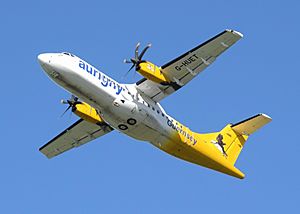
Transportation: Moving Around the Island
Cars are the main way people get around Guernsey. The island has many small roads, some of which are called 'Ruette Tranquille' (quiet streets). On these green lanes, walkers, cyclists, and horse riders have priority. The speed limit on these roads is 15 mph (24 km/h).
There are ports in St Peter Port and St Sampson. There is also an airport in Forest. These are managed by Guernsey Ports.
The States of Guernsey owns its own airline, Aurigny. They bought the airline in 2003 to make sure important flights to and from the island continued.
Guernsey has a public bus service called 'buses.gg'. There are also taxis and an electronic bike rental system called EVie.
Business and Industry: Beyond Finance
As of 2014, the finance industry is the largest part of Guernsey's economy. It creates about 40% of the island's income and employs about 21% of its workers. Banks started coming to the island in the early 1960s to avoid high taxes and strict rules elsewhere. The Guernsey Financial Services Commission regulates this industry.
Before finance grew, the island's main businesses were quarrying (getting stone) and growing plants. Plant growing declined because of rising oil prices in the 1970s. Guernsey is also home to Specsavers Optical Group and Healthspan.
Tourism: Visiting Guernsey's Charms
Guernsey has been a popular place for tourists since the Victorian era. The first tourist guide was published in 1834.
Guernsey takes part in the Britain in Bloom competition. Several parishes have won awards for their beautiful flowers and gardens. Herm island has also won the Britain in Bloom Gold Award multiple times.
The island's military history has left many forts, like Castle Cornet, Fort Grey, and a large number of German fortifications. Many of these now have museums.
Over 100 cruise ships visit St Peter Port each year, bringing more than 100,000 day-trip passengers to the island.
Taxation: How Guernsey Manages Money
Guernsey, Alderney, and Sark each collect their own taxes. However, Alderney (but not Sark) gave its tax rights to Guernsey in 1949.
The amount of tax a person pays depends on whether they live on the island. People who live in Guernsey pay 20% income tax on all their income worldwide. Non-residents only pay tax on money they earn in Guernsey. There is also a "tax cap" on how much tax residents have to pay.
Since 2008, Guernsey has three levels of company tax:
- 0% for most companies.
- 10% for banking, insurance, and other financial services.
- 20% for utility companies and income from owning land and buildings.
Guernsey does not have taxes on capital gains (profit from selling property), inheritance, or value added tax (VAT). Because of this, Guernsey has been called a tax haven.
Social Insurance Scheme payments are based on how much a person earns. Employees pay 6.8%, while self-employed people pay 11.3%.
Guernsey's People and Culture
Population and Demographics
Guernsey has a population of about 63,026 people (as of July 2016). The average age for males is 40 years, and for females, it is 42 years. The population is growing slowly. People in Guernsey live a long time; the average life expectancy is 82.47 years, which was 10th highest in the world in 2015.
Housing Rules: Who Can Live Where
Guernsey has rules about who can live in certain properties. The housing market is divided into "local market" and "open market" properties. Anyone can live in an open market property. However, local market properties are only for those who qualify. This includes people born in Guernsey (to at least one local parent), those with a housing license, or those living with someone who qualifies.
Because of these rules, "open market" properties are much more expensive to buy and rent. Housing licenses are temporary and often depend on working for a specific employer in Guernsey. These rules apply whether you own or rent the property. If your housing license expires, you might still own a property, but you can't live in it. There are no rules about who can own a property.
To become a "local" for housing, you generally need to be born to at least one Guernsey parent and live on the island for ten years within a twenty-year period. A partner of a local person can also gain local status. Once you have "local" status, it stays with you for life.
Education: Learning on the Island
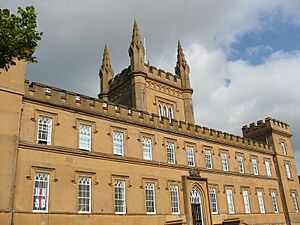
Education in Guernsey follows the English National Curriculum. There are 10 primary schools. As of 2022, the island no longer uses the 11-plus exam. This exam used to decide which secondary school students would attend. There are also three private colleges with lower schools. The States of Guernsey provides grants to help students over 11 attend these colleges.
In 2008, the school-leaving age was raised. Students can now leave school in June of the year they turn 16. This is similar to England, Wales, and Northern Ireland.
After finishing their GCSEs, students can go to the state-run Guernsey Grammar School and Sixth Form Centre for advanced studies (A Levels). They can also study vocational subjects at the Guernsey College of Further Education.
There are no universities in Guernsey. Students who go to university in the United Kingdom receive financial help from the state for their living costs and tuition fees.
Guernsey's Rich Culture
The famous French painter Pierre-Auguste Renoir visited Guernsey in 1883. He painted 15 pictures of the island's views, especially the bay and beach of Moulin Huet on the south coast.
Guernsey cattle are a well-known symbol of the island. They are valued for their rich, creamy milk, which is said to be very healthy. The beef from Guernsey cows is also known for its unique flavor.
Guernsey also has a special type of goat called the Golden Guernsey. It has a golden-colored coat. After World War II, this goat breed almost disappeared. However, one woman, Miriam Milbourne, saved the breed by hiding her herd from the Germans during the occupation.
The traditional symbol of the island is the Guernsey lily. This beautiful flower was brought to the island from South Africa.
Local Food: Tastes of Guernsey
A local treat is the ormer. This is a type of shellfish that is collected from beaches during very low tides. There are strict rules about how and when they can be gathered.
A traditional Guernsey stew is called Guernsey bean jar. It is often served at the annual Viaer Marchi festival. Its main ingredients are haricot beans, butter beans, pork, and beef. Guernsey gâche is a special bread with raisins, sultanas, and mixed fruit peel. Gâche mélée is a dessert made with spiced, chopped apples mixed into a sponge.
Languages: English and Guernésiais
English is the main language spoken by most people in Guernsey. Guernésiais, the island's traditional Norman language, is spoken fluently by only about 2% of the population. However, 14% of people say they understand some of it. Until the early 1900s, French was the only official language. All property documents were written in French until 1971. Family and place names on the island show this French history. The poet George Métivier wrote in Guernésiais.
The island's language started to disappear in the 1800s. This process sped up when most of the island's schoolchildren were sent to the UK during the German occupation from 1940 to 1945.
Literature: Stories from Guernsey
Victor Hugo arrived in Guernsey in 1855 and lived there in exile for 15 years. He wrote some of his most famous books, including Les Misérables, while on the island. His home in St Peter Port, Hauteville House, is now a museum. In 1866, he wrote a novel set on Guernsey called Travailleurs de la Mer (Toilers of the Sea), which he dedicated to the island.
Mabel Collins (1851–1927), a writer, was born in St Peter Port.
Guernseyman G. B. Edwards wrote a well-known novel called The Book of Ebenezer Le Page in 1981. It gives a look into life in Guernsey during the 20th century.
Henry Watson Fowler moved to Guernsey in 1903. He and his brother wrote important books about the English language, including The King's English and Modern English Usage, while living on the island.
The Guernsey Literary and Potato Peel Pie Society is a novel by Mary Ann Shaffer and Annie Barrows. It tells the story of the German occupation during World War II through letters between a writer and island residents.
Film: Guernsey on the Big Screen
A film version of The Guernsey Literary and Potato Peel Pie Society, starring Lily James, was released in 2018.
The 2022 British movie Marooned Awakening was filmed entirely on Guernsey. It was co-written by and stars Guernseyman Cameron Ashplant.
Media: News and Entertainment
Local TV news is provided by BBC Channel Islands and ITV Channel Television.
Guernsey has two radio stations: BBC Radio Guernsey on 93.2 FM and Island FM on 104.7 FM. Both broadcast from St. Peter Port.
The main local newspaper for the island is the Guernsey Press.
Sport: Playing on the Island
Guernsey takes part in the Island Games every two years. It hosted the games in 1987 and 2003 at Footes Lane. Guernsey also competes as its own country in the Commonwealth Games since 1970. It won its first medals in 1982 and its first gold medal in 1990.
In sports where Guernsey does not have its own international team, talented islanders can choose to play for England, Scotland, or Wales. For example, the football player Matt Le Tissier chose to play for England.
Football in Guernsey is managed by the Guernsey Football Association. The top football league is the FNB Priaulx League. In 2011–12, Guernsey F.C. was formed and became the first Channel Island club to play in the English leagues. They won their division and were promoted. They now play in level 8 of the English football pyramid. The Corbet Football Field has been important for the sport. The island recently upgraded to a larger stadium at Footes Lane.
Guernsey has the second oldest tennis club in the world, Kings, founded in 1857. The island has produced world-class tennis players like Heather Watson and professional squash players like Martine Le Moignan.
Guernsey became a member of the International Cricket Council (ICC) in 2008. The Guernsey cricket team plays in various leagues and championships.
Different types of motorsport happen on the island. These include races on Vazon beach and "sprint" races along the Vazon coast road. Le Val des Terres, a winding road, is often used for hill-climb races. The World Touring Car Champion Andy Priaulx is from Guernsey.
Horse racing started again on L'Ancresse Common in 2004 after a 13-year break. Races are held on most May Day holidays. Sea angling (fishing) is also a popular activity for both locals and visitors.
Images for kids
See also
 In Spanish: Guernsey para niños
In Spanish: Guernsey para niños




